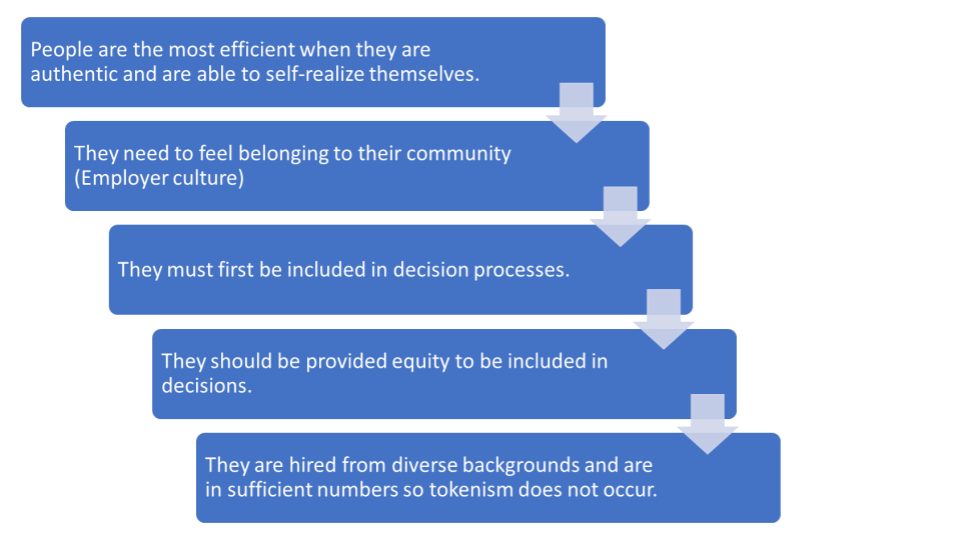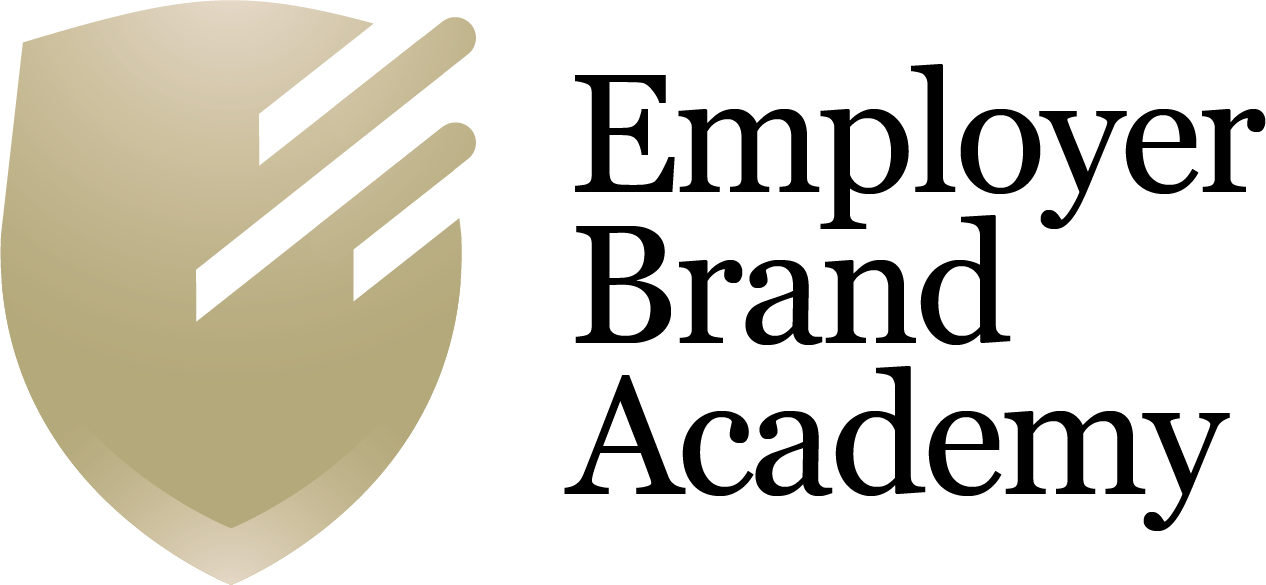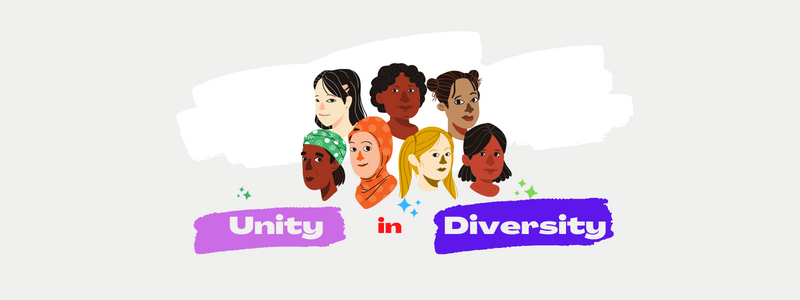In recent years, a heightened awareness of workplace injustices and inequities has underscored the need for greater diversity, equity, and inclusion (DEI) in the workplace. As a result, many organizations have recognized the need for change and begun implementing DEI initiatives to make progress. However, while some progress has been made, many projects fail due to a lack of a robust strategy. DEI is an ongoing journey that must continuously adapt to the ever-evolving status quo, and it’s not a destination.
Integrating DEI principles into your employer brand can signal to potential candidates that diversity is a core value of your organization. This can attract diverse talent and help your organization stand out in a crowded job market. Failing to do so can make your organization appear inauthentic or even alienating. Implementing DEI projects without a solid strategy can lead to alienation of both underrepresented and majority groups. It is important to provide reasons to believe in DEI initiatives before communicating them to avoid appearing deceptive. To attract and retain the best diverse talent, it is critical to understand the concepts and strategies that underpin DEI. By exploring the meanings behind each pillar of DEI, we can shed light on how to achieve the benefits of a truly inclusive workplace.

1- INTRODUCTORY REMARK
We are aware DEI is a complex and sensitive issue. Thus, it’s important to recognize that some people may feel uncomfortable or offended when discussing these topics. At our organization, we understand that everyone has their own unique experiences and perspectives. That’s why we are committed to approaching DEI with empathy, openness, and a willingness to learn.
While we acknowledge that we are not experts on this topic, we encourage our readers to seek out a variety of perspectives and resources to deepen their understanding of DEI. Our goal is to create a safe and respectful space for all readers, and we welcome feedback on how we can improve our approach to discussing these important issues.
2- DEFINITIONS OF DEI
2A- Diversity
Diversity refers to the practice or quality of including and involving people from a range of different backgrounds. These backgrounds might be social or ethnic, gender, sexual orientation, and other visible or invisible attributes. Despite our differences, we do not all have equal access to life’s possibilities. To establish an inclusive workplace, it is necessary to first practice equity.
Because each organization is unique with its own culture, there is no fixed definition for “diverse employment” requirements. However, promoting diversity can help ultimately create a more welcoming and inclusive workplace.
2B- Equity
A common mistake in the industry is confusing equality with equity, and justice with fairness. Equality means providing the same opportunities to everyone, regardless of their unique requirements. Equity, however, involves providing diverse individuals with the opportunities to professionally thrive, while accounting for societal obstacles of that minority group. This helps create a level playing field and achieve fairness and justice in the workplace for underrepresented groups.
2C- Inclusion
Inclusion involves recruiting the right talent from underrepresented groups and ensuring that they are included in decision-making processes. This can only come about through equal opportunities and fair treatment, without marginalizing individuals in any way. Inclusion means creating an environment where diverse perspectives are valued, and every employee feels that they belong and can contribute to the organization’s success. Inclusive workplaces foster a sense of community, trust, and mutual respect among colleagues from different backgrounds and perspectives.
3- BENEFITS OF DEI-INTEGRATED EMPLOYER BRAND
3A- Employee Engagement & Satisfaction
Transforming into an inclusive and engaging business culture can lead to increased wellbeing and job satisfaction. A diverse workforce encourages better teamwork, higher productivity, and a vibrant community where everyone can make their unique perspectives known. By fostering an atmosphere of belonging, employees are more likely to experience a greater sense of purpose and satisfaction.
3B- Brand (and Employer Brand) Reputation
A DEI-focused approach can positively impact a brand’s reputation, making it more attractive to potential candidates, business partners, and stakeholders. However, it is crucial to back up any claims with concrete action and authentic communication to avoid damaging the brand’s trust and credibility. Rebranding is a costly and time-consuming process, and it’s important to invest in genuine communication and action that align with the organization’s values.
3C- Customer Acquisition
Employer branding plays a significant role in customer acquisition. Customers are increasingly drawn to organizations with a strong purpose and are more likely to support companies that treat their employees fairly and equitably. By promoting an inclusive and diverse workplace, organizations can attract customers who value compassion and egalitarianism, and leverage their reputation for delivering high-quality products and services.
3D- Local and Global Social Impact
An inclusive and diverse workplace can positively impact not only employees but also suppliers, investors, and the local and global communities. By communicating transparently and authentically, organizations can spread awareness and positivity and make a lasting difference in society. Real stories of employees and candidates, as well as concrete actions and policies, can help promote an authentic and effective employer brand that resonates with a wide audience. Reaching an authentic Employee Branding stage will make your brand- and DEI-awareness reach the widest audiences.
4- GROUNDWORK FOR DEI-INTEGRATION
Integrating DEI principles into an organization’s culture and employer branding requires more than just superficial updates to recruitment materials or website content. Top job seekers can see through disingenuous attempts to project DEI values without concrete action. Therefore, it’s essential to establish a solid foundation before embarking on any DEI initiatives.
4A- Authenticity and Leader-Branding
Organizations must ensure that their DEI values are authentic and supported by concrete actions and policies. Overpromising diversity without delivering can lead to backlash and damage to the organization’s reputation. It’s crucial to accurately represent the organization’s reality and culture in all external communications. Furthermore, equity must exist in every step of the candidate and employee communication process to establish a genuine DEI-integrated employer value proposition (EVP). A top-down approach is critical in establishing a clear vision and strategy rooted in DEI principles, with leaders at the C-level bringing the organization’s purpose to life. Sharing personal stories and career paths of leaders from underrepresented communities can be a powerful tool in showing the organization’s commitment to DEI principles and creating an inclusive and inspiring workplace culture.
4B- Training for employees and communication alignment
Every employee is a brand ambassador for the organization, both internally and externally. They interact with diverse people in their day-to-day work and recruitment processes. It’s essential to ensure that all employees are aware of what makes people feel included, respected, marginalized, or offended. DEI should be at the core of the organization’s purpose and values, and it should be reflected consistently in all communication channels, from social media to job ads, from employee experience to mass communications. Recruitment teams should be trained on tools to measure and recommend the inclusiveness of job ads. Education and training are critical to ensure that the team can integrate the EVP into performance management, recognition and rewards, onboarding handbook, and other processes. Partnering with the right agency can help ensure consistency in DEI integration.
4C- Employee Experience
To create an inclusive workplace culture, it’s essential to see things from the new hire’s perspective throughout their journey. From their first days to their last, employees should have access to sufficient information and communication channels to integrate into the workforce and processes seamlessly. This includes professional and social integration, with a focus on bilateral feedback processes. It’s necessary to create an environment where employees feel comfortable providing feedback on the organization’s DEI initiatives, policies, and processes. This feedback can help identify areas for improvement and help the organization better meet the needs of its diverse workforce.
5- DEI-INTEGRATION INTO EMPLOYER BRANDING STRATEGY
Be ready to continuously update what DEI means at your company. As an organization’s position and purpose evolve, so should its DEI approach and initiatives. The concept of Diversity, Equity, and Inclusion has evolved significantly over time, and organizations need to be agile and committed to change. However, certain priorities should remain constant throughout the DEI journey.
5A- Reality Showcase
Ensure that your content also reflects reality, not just aspirations. You can update your messaging and visuals at every step of your DEI goals to align with your current reality.
5B- Project Timeline
Have a living, breathing timeline to showcase your DEI goals transparently and honestly. This will help show that you have a clear DEI strategy and goals, making your employer brand more attractive to all.
5C- Project Communication
Clearly communicate your DEI initiatives, such as office and online accessibility, idea platforms, engagement platforms, mentorship and sponsorship programs, positive communication workshops, and more. Reach employees and candidates through organic means to ensure they are aware of your initiatives. For instance, pair underrepresented employees with mentors or sponsors to offer guidance and support. This way, individuals from diverse backgrounds can advance in their careers and feel included in the workplace. Furthermore, positive communication workshops can provide a safe space to discuss diversity and inclusion, and learn strategies to build an inclusive workplace culture. These are just a few of the many DEI initiatives organizations can implement to promote diversity, equity, and inclusion.
5D- Data Management
Data and metrics play an important role in DEI integration. Organizations can use metrics such as employee demographics, retention rates, and promotions to evaluate their DEI initiatives. They can identify areas for improvement and develop targeted strategies to address issues related to diversity and inclusion. Additionally, data can be used to demonstrate organizations’ commitment to DEI, providing transparency and accountability. It’s important to regularly review and update metrics, ensuring alignment with DEI goals and strategies. This helps organizations ensure progress towards their objectives.
6- CHALLENGES FOR DEI
DEI integration can bring many benefits to an organization, but it’s important to recognize the challenges that may arise. Implementing DEI training and education programs may require significant time and resources, and may be met with resistance or skepticism from some employees. Recruiting diverse talent may also pose challenges in certain industries or regions.
To address these challenges, organizations must take a proactive approach by seeking input and feedback from employees and external stakeholders, engaging in open and honest communication, and addressing any systemic barriers to diversity and inclusion. By doing so, organizations can create a more inclusive and equitable workplace culture that benefits all employees.
If you’re considering DEI integration, be prepared to address potential obstacles and take a proactive approach to ensure successful implementation. By doing so, you can reap the benefits of a diverse and inclusive workforce.
Challenges and obstacles that organizations may face in implementing DEI initiatives may be one or the combination of the points below.
6A- Resistance to change
One of the biggest challenges when implementing DEI initiatives is resisting change. Employees often feel like their interests and perspectives are not being taken into account, or that changes are being imposed from the top down without their input. Managers and senior leaders may also resist DEI initiatives due to a lack of commitment to the values and goals of diversity and inclusion, or a fear that the changes will disrupt power dynamics. To ensure the successful implementation and acceptance of DEI initiatives, it is essential to involve all stakeholders in the decision-making process and ensure transparency in the transition.
6B- Lack of diversity in leadership
A lack of diversity in leadership can be a major impediment to DEI integration. This can create the perception that the organization is not genuinely devoted to diversity and inclusion. Without diverse representation at the highest levels of decision-making, it is difficult to achieve meaningful progress on DEI initiatives. Moreover, without diverse perspectives at the leadership level, developing effective strategies for recruiting and retaining diverse talent can be challenging. To ensure success, organizations must prioritize diversifying their leadership teams and creating a culture of inclusivity.
6C- Systemic barriers to diversity and inclusion
Organizations may face systemic barriers to diversity and inclusion, such as unconscious bias in hiring decisions, performance evaluations, and promotions. Even with the best intentions. This can lead to disparities in representation and opportunities for underrepresented groups. Moreover, workplace culture may perpetuate harmful stereotypes and exclude certain groups from informal networks and social activities, resulting in barriers to inclusion. To overcome this, organizations should strive to create an environment of inclusivity.
6D- Limited resources
Implementing DEI initiatives requires time, resources, and expertise that may be limited in some organizations. This is especially true in small businesses or nonprofit organizations. These organizations may struggle to allocate resources to DEI initiatives, due to the need to address urgent priorities. Furthermore, the lack of dedicated HR staff or DEI specialists may leave these organizations without the necessary expertise.
6E- Difficulty in measuring progress
Measuring progress towards DEI goals can be challenging. Without access to reliable data or metrics, it can be hard to track progress on retention rates, promotion rates, or employee engagement. A lack of a clear baseline or benchmark for comparison can make it difficult. Moreover, collecting data on employee demographics can be a challenge for organizations. Employees may be hesitant to self-identify, or the organization may operate in a jurisdiction with data collection restrictions.
By being aware of these challenges and obstacles, organizations can take a proactive approach to addressing them and making meaningful progress towards DEI integration. This may involve seeking input and feedback from employees, engaging in open and honest communication, and investing in resources and expertise to support DEI initiatives.
To learn more, you can join a free week session of Employer Brand Academy certificate courses here or you can download our free ebook on creating an authentic employer brand here.

